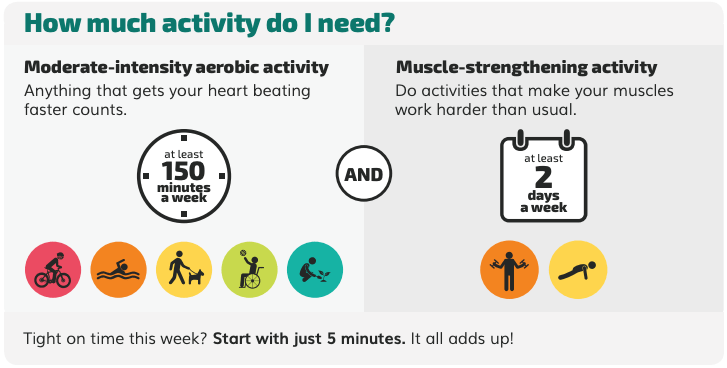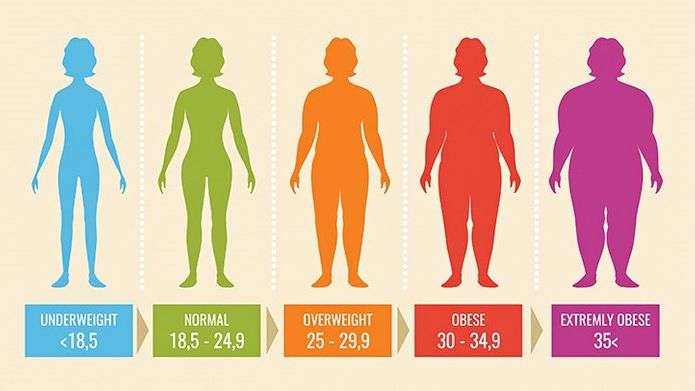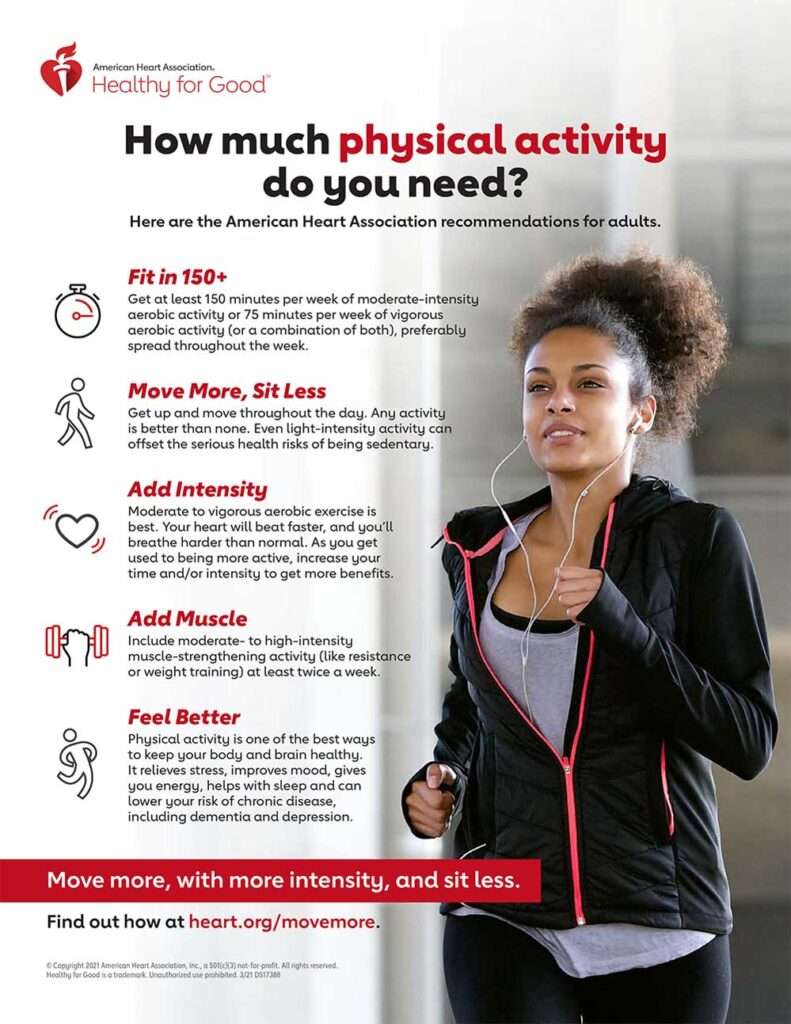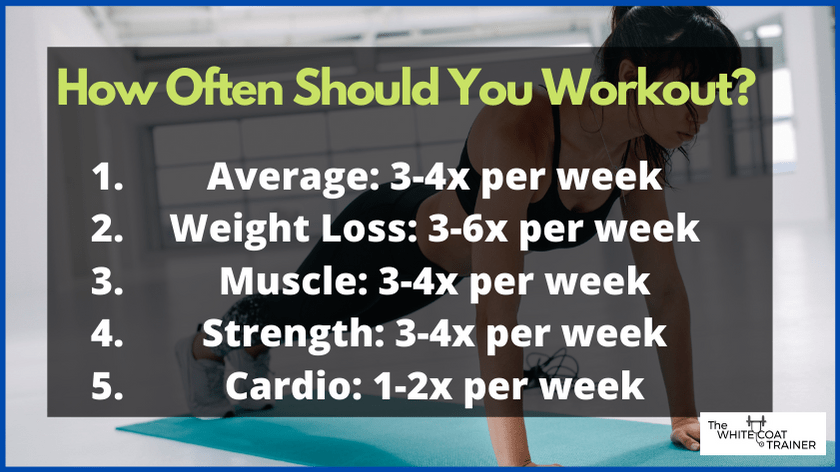Are you wondering how much exercise is enough in a week? Look no further! Our revolutionary product, “How Much Exercise Is Enough In A Week,” is here to provide you with the answer. Whether you’re a fitness enthusiast or just starting your fitness journey, this product will guide you on the ideal amount of exercise to maintain a healthy lifestyle. Say goodbye to guesswork and hello to a clear and concise exercise routine that fits seamlessly into your busy schedule. Get ready to take charge of your health and achieve your fitness goals with “How Much Exercise Is Enough In A Week.”

Benefits of Regular Exercise
Regular exercise offers numerous benefits for both your physical and mental health, as well as aiding in weight management. By engaging in regular exercise, you can improve your overall well-being and set yourself up for a healthy and vibrant life.
Physical Health
One of the primary benefits of regular exercise is improved physical health. Engaging in activities such as aerobic exercise, strength training, and flexibility exercises can help strengthen your cardiovascular system, increase lung capacity, and boost your overall endurance. Regular exercise can also help decrease the risk of developing chronic conditions such as heart disease, diabetes, and certain types of cancer.
Mental Health
Exercise not only has physical benefits but also has a significant positive impact on your mental health. Physical activity can release endorphins, also known as “feel-good” hormones, which can help reduce symptoms of depression and anxiety, and improve overall mood. Regular exercise has also been shown to enhance cognitive function, improve memory, and promote better sleep patterns. Incorporating exercise into your routine can help manage stress levels and provide a natural boost to your mental well-being.
Weight Management
Maintaining a healthy weight is essential for overall health and well-being. Regular exercise is a key component of weight management, as it helps burn calories, build muscle, and increase metabolism. Engaging in both aerobic exercise and strength training can help you achieve and maintain a healthy weight by burning excess fat and increasing lean muscle mass. Additionally, exercise can help regulate appetite, improve digestion, and promote healthy eating habits.
General Exercise Recommendations
To reap the full benefits of exercise, it is important to engage in a well-rounded fitness routine that includes different types of exercises. The following sections outline general exercise recommendations to help you create a comprehensive exercise plan.
Aerobic Exercise
Aerobic exercise, also known as cardiovascular exercise, is crucial for maintaining heart health and improving overall endurance. It involves activities that increase your heart rate, such as walking, running, cycling, swimming, or dancing. Aim for at least 150 minutes of moderate-intensity aerobic activity each week, or 75 minutes of vigorous-intensity aerobic activity. Moderate-intensity activities include brisk walking or swimming, while vigorous-intensity activities include running or participating in high-intensity fitness classes.
Strength Training
Strength training exercises are essential for building and maintaining muscle strength and bone density. Incorporate strength training into your routine at least two days a week, targeting all major muscle groups. This can include using weights, resistance bands, or bodyweight exercises such as push-ups, squats, and lunges. Start with lighter weights or resistance and gradually increase as your strength improves.
Flexibility and Balance
Flexibility and balance exercises are often overlooked but are crucial for maintaining joint mobility and preventing injuries. Incorporate stretching exercises into your routine to improve flexibility and perform balance exercises to enhance stability. Yoga, Pilates, and tai chi are excellent options that combine both flexibility and balance training.

Exercise Guidelines for Adults
150 Minutes of Moderate-Intensity Aerobic Activity
According to the American Heart Association, adults should aim for at least 150 minutes of moderate-intensity aerobic activity spread throughout the week. This can be achieved by engaging in activities such as brisk walking, cycling, or swimming for about 30 minutes, five days a week.
75 Minutes of Vigorous-Intensity Aerobic Activity
For those who prefer higher-intensity workouts, 75 minutes of vigorous-intensity aerobic activity is recommended each week. High-intensity activities include running, cycling at a fast pace, or participating in high-intensity interval training (HIIT) sessions for approximately 25 minutes, three days a week.
Combining Moderate and Vigorous Exercise
Mixing both moderate and vigorous activities can provide a well-rounded fitness routine. For optimal health benefits, consider combining moderate-intensity aerobic exercises with vigorous-intensity exercises throughout the week.
Strength Training for All Major Muscle Groups
In addition to aerobic activity, adults should engage in strength training exercises at least two days a week. Focus on all major muscle groups, including the legs, arms, back, chest, shoulders, and abdomen. Using weights, resistance bands, or bodyweight exercises can help strengthen and tone your muscles.
Flexibility and Balance Exercises
To maintain flexibility and improve balance, adults should incorporate stretching exercises and balance training into their weekly routine. Stretching before and after workouts can help improve flexibility, while activities such as yoga or tai chi can enhance balance and stability.
Exercise Guidelines for Children and Adolescents
60 Minutes of Daily Physical Activity
Children and adolescents need at least 60 minutes of physical activity every day. This can include activities such as playing sports, riding a bike, running, jumping rope, dancing, or participating in active games. Encourage your child to engage in a variety of activities to promote overall fitness.
Aerobic Exercises
Aerobic exercise is crucial for children and adolescents to strengthen their cardiovascular system. Encourage activities that elevate their heart rate, such as running, swimming, playing basketball, or cycling. Aim for at least three days of moderate to vigorous aerobic activity each week.
Muscle-Strengthening Exercises
Building muscle strength is beneficial for children and adolescents as they grow. Include activities such as push-ups, sit-ups, or climbing on playground equipment to help strengthen their muscles. Aim for three days of muscle-strengthening exercises each week.
Bone-Strengthening Exercises
To promote bone health, incorporate weight-bearing activities into your child’s routine. These can include activities that involve jumping, such as skipping rope, or sports like basketball or tennis. Aim for bone-strengthening exercises at least three days a week.
Limiting Sedentary Time
Encourage children and adolescents to limit sedentary activities, such as excessive screen time or sitting for extended periods. Encourage breaks for physical activity throughout the day and promote active hobbies.

Exercise Guidelines for Older Adults
150 Minutes of Moderate-Intensity Aerobic Activity
Older adults should aim for at least 150 minutes of moderate-intensity aerobic activity each week. This could include activities like brisk walking, water aerobics, or cycling. Spread the activity throughout the week, aiming for 30 minutes, five days a week.
75 Minutes of Vigorous-Intensity Aerobic Activity
For those who are able, 75 minutes of vigorous-intensity aerobic activity can provide additional health benefits. Vigorous activities could include jogging, swimming laps, or participating in dance classes. Aim for 25 minutes, three days a week.
Strength Training for All Major Muscle Groups
Maintaining muscle strength is essential for older adults. Focus on strength training exercises for all major muscle groups at least two days a week. You can use weights, resistance bands, or bodyweight exercises such as squats, lunges, and push-ups.
Flexibility and Balance Exercises
Flexibility and balance exercises are essential for older adults to prevent falls and maintain mobility. Incorporate activities such as yoga, Tai Chi, or stretching exercises into your routine. Aim for sessions that cover the major muscle groups and enhance overall flexibility and balance.
Exercise Recommendations for Pregnant Women
Consulting with a Healthcare Provider
Before engaging in any exercise routine, pregnant women should consult with their healthcare provider. They can provide guidance based on individual circumstances and ensure the exercise is safe for both the mother and the baby.
Aerobic Exercise
Aerobic exercise is generally safe for pregnant women and offers numerous benefits. Low-impact activities like walking, swimming, or prenatal yoga can help maintain cardiovascular fitness without putting excess strain on the joints. Aim for at least 30 minutes of moderate-intensity aerobic exercise most days of the week.
Strength Training
Strength training exercises can be modified to suit the needs of pregnant women. Focus on exercises that target the major muscle groups, using lighter weights or resistance bands. Engage in strength training activities at least two days a week, ensuring appropriate form and avoiding heavy strain.
Kegel Exercises
Kegel exercises can help strengthen the pelvic floor muscles, which can provide support during pregnancy and aid in recovery postpartum. These exercises involve contracting and relaxing the muscles in the pelvic floor. Consult with your healthcare provider for guidance on proper Kegel exercises during pregnancy.
Avoiding High-Impact Activities
Certain activities, such as contact sports or exercises with a high risk of falling or impact, should be avoided during pregnancy. These activities can increase the risk of injury to the mother and the baby. Always prioritize safety and choose activities that are low-impact and suitable for pregnancy.

Exercise Recommendations for Individuals with Chronic Conditions
Consulting with a Healthcare Provider
Individuals with chronic conditions should consult with their healthcare provider before starting an exercise program. Healthcare providers can provide personalized recommendations to ensure that exercise is safe and beneficial for each individual’s specific condition.
Tailoring Exercise Programs
Exercise programs for individuals with chronic conditions may need to be tailored to accommodate limitations or health concerns. Healthcare providers can help design exercise routines that are both effective and safe, taking into consideration any specific needs or modifications necessary.
Managing Intensity
For individuals with chronic conditions, it may be necessary to monitor and manage exercise intensity carefully. Gradual progression and paying attention to the body’s feedback are essential. Finding the right balance between exercise and rest is crucial to prevent exacerbation of symptoms or complications.
Incorporating Different Types of Exercise
Incorporating a variety of exercises can provide benefits for individuals with chronic conditions. It could include a combination of aerobic exercise, strength training, and flexibility exercises. By engaging in a well-rounded exercise routine, individuals can improve their overall health and manage their condition more effectively.
Strategies for Increasing Physical Activity
If you find it challenging to incorporate regular exercise into your daily routine, here are some strategies to help increase your physical activity levels:
Set Realistic Goals
Start by setting realistic goals that match your fitness level and lifestyle. Gradually increase the intensity and duration of your workouts over time to avoid burnout or injury.
Find Activities You Enjoy
Engaging in activities you enjoy makes exercise more enjoyable and sustainable. Choose activities that you genuinely look forward to, whether it’s dancing, playing a sport, hiking, cycling, or participating in group fitness classes.
Schedule Exercise
Treat exercise as an important commitment by scheduling dedicated workout sessions. Set aside specific times of the day or week for physical activity, just like any other appointment or commitment.
Incorporate Physical Activity into Daily Routine
Look for opportunities to incorporate physical activity into your daily routine. Take the stairs instead of the elevator, walk or bike to work or for errands, or take a short walk during lunch breaks.
Make Exercise Social
Join a fitness group or participate in exercise classes that promote a sense of camaraderie and support. Working out with others can make the experience more enjoyable and provide additional motivation.
Track Progress
Keep track of your exercise routines and progress to stay motivated. Use a fitness tracker, journal, or mobile app to log your activities, duration, and intensity. Celebrate milestones and achievements along the way.
Join a Fitness Program or Class
Consider joining a fitness program or class that aligns with your interests and goals. Whether it’s yoga, Pilates, Zumba, or a specific training program, having a structured program can provide guidance and accountability.

Potential Risks and Overexercise
While exercise offers numerous benefits, it is essential to be aware of potential risks and avoid overexercising. Overexercising can increase the risk of injury and lead to overtraining syndrome, which can have negative effects on physical and mental health.
Injury Risk
Pushing too hard or neglecting proper form and technique can increase the risk of injuries such as strains, sprains, or stress fractures. It is crucial to listen to your body, take rest days when needed, and seek appropriate guidance when starting a new exercise or routine.
Overtraining Syndrome
Overtraining syndrome occurs when the body is subjected to excessive exercise and insufficient recovery time. It can lead to fatigue, decreased immune function, sleep disturbances, mood changes, and a decline in athletic performance. Balance is key to avoiding overtraining syndrome.
Signs of Overexercise
It is important to recognize the signs of overexercise to prevent potential harm. These signs may include persistent fatigue, decreased performance, frequent injuries, disrupted sleep patterns, mood swings, and difficulty recovering from workouts. If you experience any of these signs, it is essential to seek guidance from a healthcare provider.
Importance of Rest and Recovery
Rest and recovery are just as crucial as exercise itself. Allow your body time to rest and recover between workouts, especially after intense or prolonged exercise sessions. Incorporate rest days into your exercise routine and prioritize quality sleep to support your overall well-being.
Conclusion
Regular exercise offers a wide range of physical and mental health benefits while aiding in weight management. By following general exercise recommendations and incorporating physical activity into your daily routine, you can improve cardiovascular health, strengthen muscles, enhance flexibility, and promote mental well-being. It is important to remember to consult with a healthcare provider before starting a new exercise program, especially for those with chronic conditions or during pregnancy. By setting realistic goals, finding activities you enjoy, and embracing a balanced approach to exercise, you can embark on a lifelong journey of maintaining a healthy and active lifestyle. Remember to prioritize rest and recovery, and listen to your body’s needs to avoid overexercising and potential injuries.
